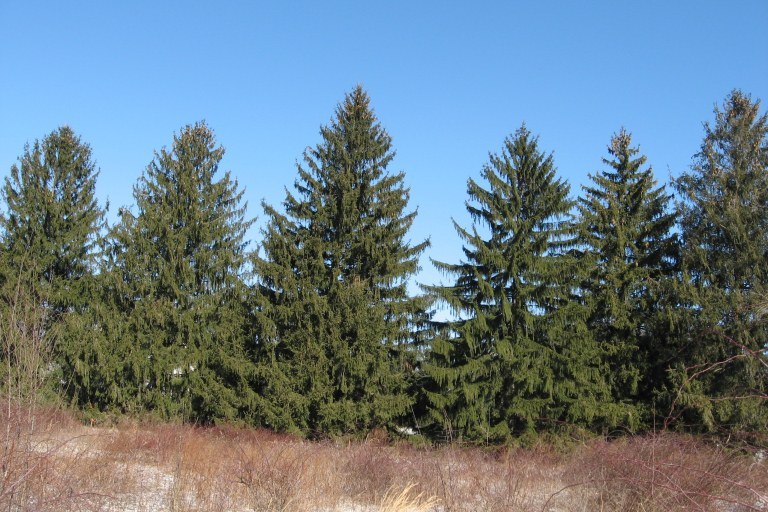Posted: February 15, 2024
The Norway spruce (Picea abies) is a member of the pine family Pinaceae. Norway spruce are large evergreen trees with long, narrow cones. When pulled off from their long pendulous branches, their needles leave a peg-like petiole on the stem. These spruce trees are native to Europe's northern, central, and eastern mountainous portions.

Norway spruce (Picea abies) by Richard Webb on Bugwood.org. CC BY
Norway spruce was introduced to the British Isles from the continent as early as 1500. It is widely planted in North America, particularly in the northeastern United States and adjacent Canada, plus the Pacific Coast and the Rocky Mountain states to the west.
We are familiar with the spruce as a popular holiday tree decoration. The Norway spruce has been a source of light and hope for many years. Norway spruce trees were planted on surface mine spoils in the mid-1900s. During World War II, Norway shipped a massive spruce tree to London each year, even during the long nights of war and destruction. Each year, Norway also gifts a Norway spruce to Washington, D.C., for its Christmas display. The wood of the Norway spruce is widely used for construction, pulp, furniture, and musical instruments.
Norway spruce is a fast-growing evergreen coniferous tree, growing 60 to over 100 feet tall when mature. The light requirements are full sun, and the tree is very useful as a windbreak in wide open spaces. It is tolerant of many soils except excessively dry ground. Norway spruce trees bloom in May with small pink-red male pollen cones and ruby-red female cones. After wind pollination, the female cones mature into seed-bearing cones. Propagation is by seed, but cultivars are propagated from cuttings and grafting.
The needled foliage is a lovely medium green. It has branchlets that typically hang downwards and bears the largest cones of any spruce, four to seven inches long. The Norway spruce tree produces a wonderful fragrance from its pointed needles. In some respects, the needles are similar to Douglas-fir (Pseudotsuga menziesii) but have sharper, spikey square needles.
A local gardening friend shared Norway spruce cones with me to make potpourri. The cones fall at prolific rates in her yard from her long-standing Norway spruce trees. She shares that a great-grandfather planted her trees, which may be 200 years old. They are now more than twice the height of her home. Shown here are a few of her trees. Where in the world would you find the oldest known tree? In the White Mountains of California is "Methuselah," a 4,885-year-old Great Basin bristlecone pine (Pinus longaeva).
This European native is successful in USDA Plant Hardiness Zones 2 through 7. Norway spruce is extremely cold hardy, with frost tolerance down to -40°F. Soil should be slightly acidic and well-drained.
There are more than 150 known cultivars of Norway spruce, from dwarf to weeping varieties. Popular cultivars include:
- 'Nidiformis' - Also known as the bird's nest spruce, this small landscape tree grows about 3 feet high.
- 'Pumila Glauca' - This dwarf variety has lovely blue-green needles and grows about 4 feet tall.
- 'Pendula' - This weeping variety can grow up to 60 feet tall but reaches only about 5 feet wide at maturity.
Norway spruce provides shelter to many birds, like hawks and owls, which nestle in the upper part of the tree. In woodland settings, the tree provides habitat to other furry wild creatures. Squirrels prefer the cone's seeds to those from other trees.
In North America, the Norway spruce is host to the western spruce budworm (Choristoneura freemani) and mountain pine beetle (Dendroctonus ponderosae) but is not known to be a significant problem among Norway spruce in Pennsylvania. The spruce gall adelgids, family Adelgidae, are insects related to aphids. Adelgids produce galls in the new buds of spruce trees. The galls are spikey, pineapple-shaped, and may be mistaken for cones. There are several species of adelgids, some native and some introduced, that disfigure spruce trees. Improper fertilizer application on a Norway spruce can promote frost damage by prolonging its growth late into the season. The formation of the waxy cuticle on the needles may be delayed, causing damage by the cold weather. The best prescription for a healthy Norway spruce is maintaining tree vigor with just the right amount of watering and mulching. Pruning away diseased branches is acceptable in the Norway spruce. Perennial companion plants for Norway spruce include Solomon's seal (Polygonatum spp.), Astilbe (Astilbe spp.), wild ginger (Asarum spp.), and spikenard (Aralia spp.) With the history and popularity of the Norway spruce, it is certainly a delight to many. When I think of snow, northern climates, or winter holidays, the Norway spruce remains my choice for a tree of hope and light.
Written by Tiffany Riebel, Penn State Master Gardener Trainee

